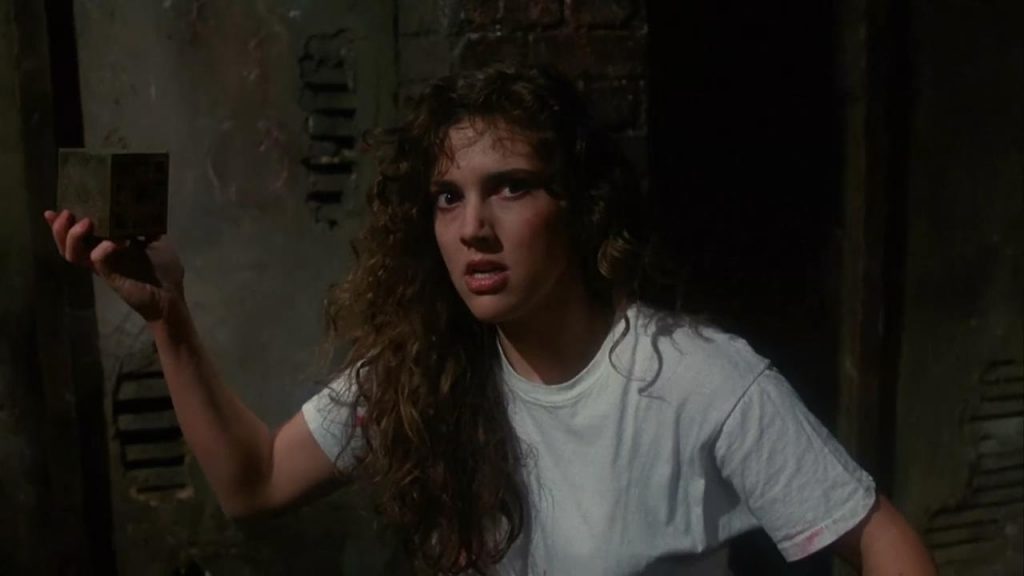Hellraiser is a 1987 horror film, based on a novella, “The Hellbound Heart”, by Clive Barker, and the film was also written and directed by Barker.
For the notoriety attached to the Hellraiser franchise, there’s very little of the hyper-sadomasochistic Cenobites and their apparent leader, the iconic Pinhead, in the first film. The Cenobites are a background threat to the main action. They appear in only a few scenes, and there’s little exploration of what they’re about.

Hellraiser is a Gothic haunted house story. Frank, a man said to have spent his life in hedonism, acquires a mysterious box. This brief scene is set in an unspecified Middle Eastern country, once again linking deviant sexuality with the Orient.

Back home in the abandoned house where he has been squatting, Frank opens the puzzle box. Hooked chains reach out and bind him. The Cenobites appear, tear him apart and rebuild him into an art exhibition, then disappear.
Sometime later, Frank’s brother Larry takes possession of the house, along with his wife Julia. There’s a lot of tension between husband and wife, and between Julia and Larry’s daughter Kirsty. In flashbacks, we learn that Julia had a torrid affair with the domineering, aggressive Frank before his disappearance.
When moving in, Larry gashes his hand open on a nail and drips the blood on the floor of the attic where Frank summoned the Cenobites. This is enough to bring Frank into a kind of half-life, only a portion of his living body.

Julia discovers this and at Frank’s behest, starts seducing men and luring them back to the attic where she kills them and Frank consumes them, rebuilding his body step by step.
It would be easy, and incorrect, to see Julia as just Frank’s minion. For most of the story Frank is so limited and dependent on her that she becomes the primary character. It’s also clear while she’s doing this for Frank, she’s acting on her own desires. Supposedly, when the crew were struggling to come up with a good title, a 60-year-old female crew member called it, “What a woman will do for a good screw.” It’s kind of odd that a franchise known for S&M imagery began with a story mainly about a middle-aged woman wanting to get laid.
At this point, Frank shows the box to Julia and explains why he acquired and opened the box.
Frank: “It opens doors.”
Julia: “What kind of doors?”
Frank: “Doors to the pleasures of heaven or hell. I didn’t care which. I thought I had gone to the limits. I hadn’t. The Cenobites gave me an experience beyond limits. Pain and pleasure indivisible.”

Their plan goes wrong because Kirsty stumbles into this scene, grabs the box, and runs. Stuck in a hospital, she opens the box and encounters the Cenobites and other monsters.
Pinhead: “The box. You opened it. We came.”
Kirsty: “It’s just a puzzle box.”
Pinhead: “Oh, no. It is a means to summon us.”
Kirsty: “Who are you?”
Pinhead: “Explorers in the further regions of experience. Demons to some. Angels to others.”
Kirsty: “It was a mistake. I didn’t mean to open it. It was a mistake. You can go to Hell!”
Female Cenobite: “We can’t. Not alone.”
Pinhead: “You solved the box. We came. Now you must come with us to taste our pleasures.”
Kirsty: “Go away and leave me alone.”
Pinhead: “Oh, no tears, please. It’s a waste of good suffering.”
Kirsty makes a deal with Cenobites that she can find Frank, the only one to escape them. This sends her back to the house, where she finds that Frank is wearing her father’s skin like a suit. In the final confrontation, Kirsty uses the box to summon and dismiss the Cenobites, taking Frank with them.

Part of what made the Hellraiser mythos interesting was the idea that the Cenobites had nothing to do with conventional Judeo-Christian morality. They want to be the way they are, and do what they do. What they offer is neither punishment nor reward, just an experience to choose. The people they abduct are apparently drawn to what the box represents. Frank is just a guy who chickened out on the deal and wanted out. For someone who supposedly knew the limits of pain and pleasure, he couldn’t keep up with the Cenobites.
This is also where things get muddled. For instance, what dark desires are lurking in Kirsty that makes her a suitable candidate for the box? All she seems to want is to hang out with her boyfriend; they even sleep in separate beds. Julia seems like a much better prospect.
In the original novella by Barker, “The Hellbound Heart”, this is subject is somewhat explored, but the film does little with this idea. What’s left is a conventional ghost story with a bit of kinkiness around the margins.
Like From Beyond, Hellraiser implies that sadomasochism is a step on the road to hell, a state of being that is both terrifying and seductive.
From what I understand, the film rights to Hellraiser are owned by a company that keeps putting out cheap sequels (which are standard demon stories) every few years so they don’t have to release the rights. Barker himself hasn’t had any involvement since the fourth installment.




[…] Stuff to Blow Your Mind podcast has an episode on the original Hellraiser film and the short story it was based on, Clive Barker’s “The Hellbound Heart”. […]